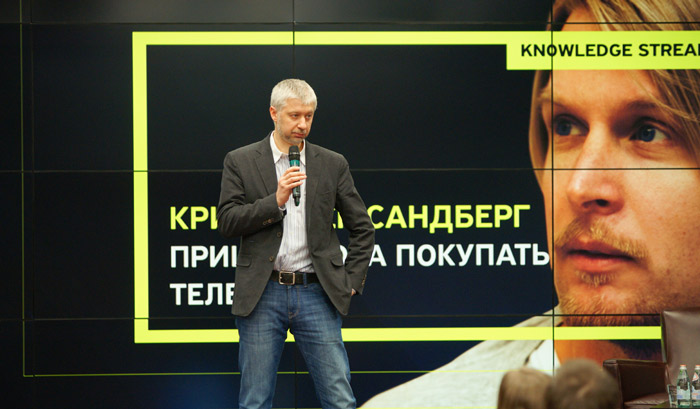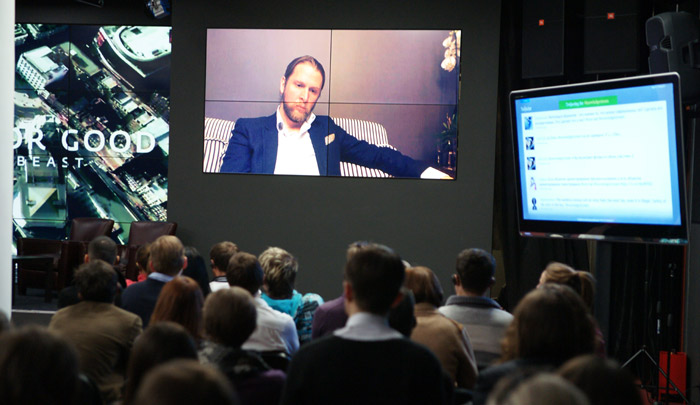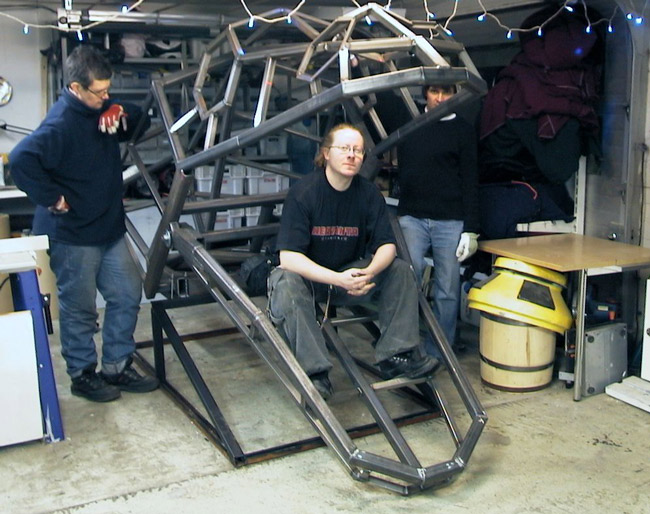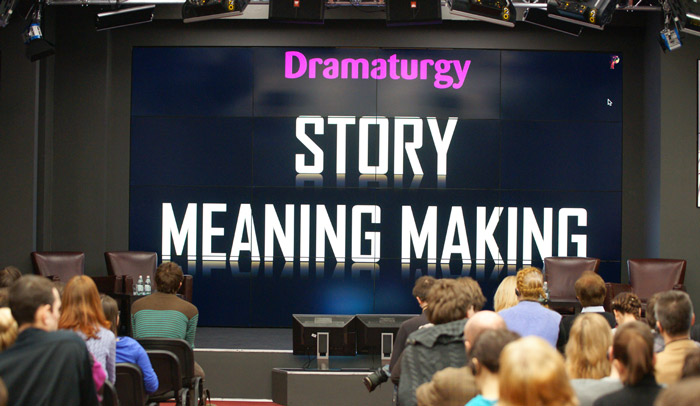Practical advice on how to arrange a MMORPG in real life - or why you will need to buy a TV again soon

Christopher Sandberg is the man who made the viewers of the “Conspiracy for Good” show run through the streets of London and complete quests fighting against a fictional dishonest corporation. On February 3, he gave a lecture in Russia, in which he tried to prove that it was too early to throw such a useless object as a TV.
Why is modern television dead?
In recent years, the usual media environment has changed dramatically. Previously, creatives invented something, and then they found out what people think about their product. Now it is possible to fully include the audience in the teleproject. It is simply impossible to do the production of TV content in the old way.
')
If something happens to a person on the street, look what happens: dozens of other people take it off. The event, in fact, happens to him alone, but the rest work as reporters.
You need not only a dialogue with the audience, but also something that makes you create the plot together. For example, before we just watched good movies, then a choice appeared by voting (which, in fact, very few people use). Next - media products, where we contribute to the plot (note - many compared the game Mass Effect with an interactive film) . And then you need to be ready that the storyline will be very much modified. It's like Web 2.0 - powerful, but it can be unpredictable.

Transmedia
At first we read books. Then came the era of multimedia, when it was possible to record sound, pictures and video on the disc: but in terms of interestingness it was like the same good old books. Next is “crossmedia”, when you can access the same content from different devices from a computer to a smartphone and a TV. Now everyone is talking about “social media” - it’s not even important how the signal is delivered, how people consume content.
Transmedia is media that cross different boundaries and include both social and technological components. What is important here is not the channel itself, but the fact that these media are perceived as if they belong to the masses. As closed torrent trackers, for example, Payret Bey, the notorious. From the point of view of the audience, this is a very important project: it is a sign that people want to exchange information with each other.
It seems that the future of media, the future of feature films will be not so much technological as social. Even in modern media, people can already participate from computers, from mobile phones and so on. New content just has to take into account these factors.
Imagine that you are really trying to attract an audience to the formation of the plot. So, there is content that you create as a director. It is important to understand that there is your plot - and there is a part that is formed by the audience, which is beyond your control.
Here, for example, is a story about friendship. You can show how a boy hugs a girl — or you can translate it from the content language to the action language. A person registers on the site, you send an SMS: “Hug somebody.” What he does himself will create a stronger emotional response. About such things we do in our company.

How should a screenwriter work?
Today, the scriptwriter can no longer write a linear script. There is a prologue, an epilogue, a climax, in which people are usually the most attached to your product. In the film, you can only identify yourself with the character, but all frames will always be the same everywhere. In games, one character is different story lines, different styles and different events. In multiplayer games, the difference is even greater: there the stories overlap each other. In Warcraft, for example, people do not discuss demonic swords there, they really discuss problems with their girlfriends, problems associated with finding a job and the like.
Modern social networks resemble games: you must score points ( note: for example, karma on Habré or Achivki in Forsquare ). In most cases, in social media, everyone has the opportunity to participate in the creation of a common history. It may be some little things, but when you post a post and like it, you realize that your values are important to other people. Plus there is a geo-referencing, which now also gives a lot.
When your child has done some toy in the classroom for work, he brings it home. She is not necessarily beautiful, but he will love her because he has made it with her own hands, and will love her more than any purchased one. After all, he invested in her strength, time and soul. The same applies to TV content: a feeling of co-creation gives a strong binding.

What is common between the scenario and the PLO?
Now there is no main character and antihero: there is an audience that can act on equal terms. Your listeners, your viewers will eventually enter the closest circle of friends of your characters, can become their agents, and so on. For example, the heroine decides to go down to the basement where a maniac with a knife is sitting. She can shout or send a tweet - and she will not go down. And if she does, the film will be very boring — it turns out that new opportunities create a lot of difficulties.
In the end, we come to the idea of a plot with key points where the forks converge: like dialogues in computer games. There are lots of different approaches, but there are not so many ways out of this dialogue. But in reality, everything is more complicated, there are no binary relations, so script writers usually draw curves with key points.
Here is a story from one project (in the lecture video from 19:46):
Here one of the characters is abducted. As you well see with a pretty bad recording made by a surveillance camera. Then someone hacked into the server of the company that served the video cameras in the area, in order to see where mine went, which the girl was pushed into. In order to go for it you need to be seriously interested in this project. And, of course, every person who falls into such a story, he can somehow modify it. Here, you see, there were people who knew that those who had kidnapped Marika brought her to this cafe. They went with her here. They presented some kind of ID downloaded from the site, persuaded the guard to give them the keys to the car and found the main character in the car connected. Itself and released. And then hijacked the car. Of course, all this required preparation. We sent there a certain number of extras who were supposed to watch the whole story and intervene if something happens. Of course, it was necessary to work with the guards so that they would give the keys. It turns out as an object-oriented programming object-oriented narration.
Here we understand that the participants of the show will find and save the girl, but we don’t know yet how it works.
Together with the Finns was made «Dragon bane». This is a village in the forest in the style of the Vikings, people helped to build it or send money. And then they came for a few weeks, lived there, ate the food that the Vikings ate, take part in a mystical story. At the end, the dragon challenge ritual is performed: a great example of complete implantation. This project could not start if it were not for the investments of each of the participants.

Dragon and temple from the project.

Dragon head
Summing up : television has long been outdated because it does not use interactivity to the full - Christopher tried to draw a picture where television works to the full, and, in fact, spoke about new content reporting channels that will be far after television. Later in the lecture, Sandberg gives examples of real scenario construction for a large social project of Nokia: about how introductory data are made, how the “sowing” is performed and how the audience is involved.

The full lecture can be viewed in the Knowledge Stream project in two languages (ibid. - audience questions). I hope this lecture gave you a couple of ideas on what you can do in terms of content - if so, our goal has been achieved. The next lecture of Barlow (here is the event on Habré ) will be devoted to how to manage information online and how to defend its freedom at the state level.
Source: https://habr.com/ru/post/137765/
All Articles